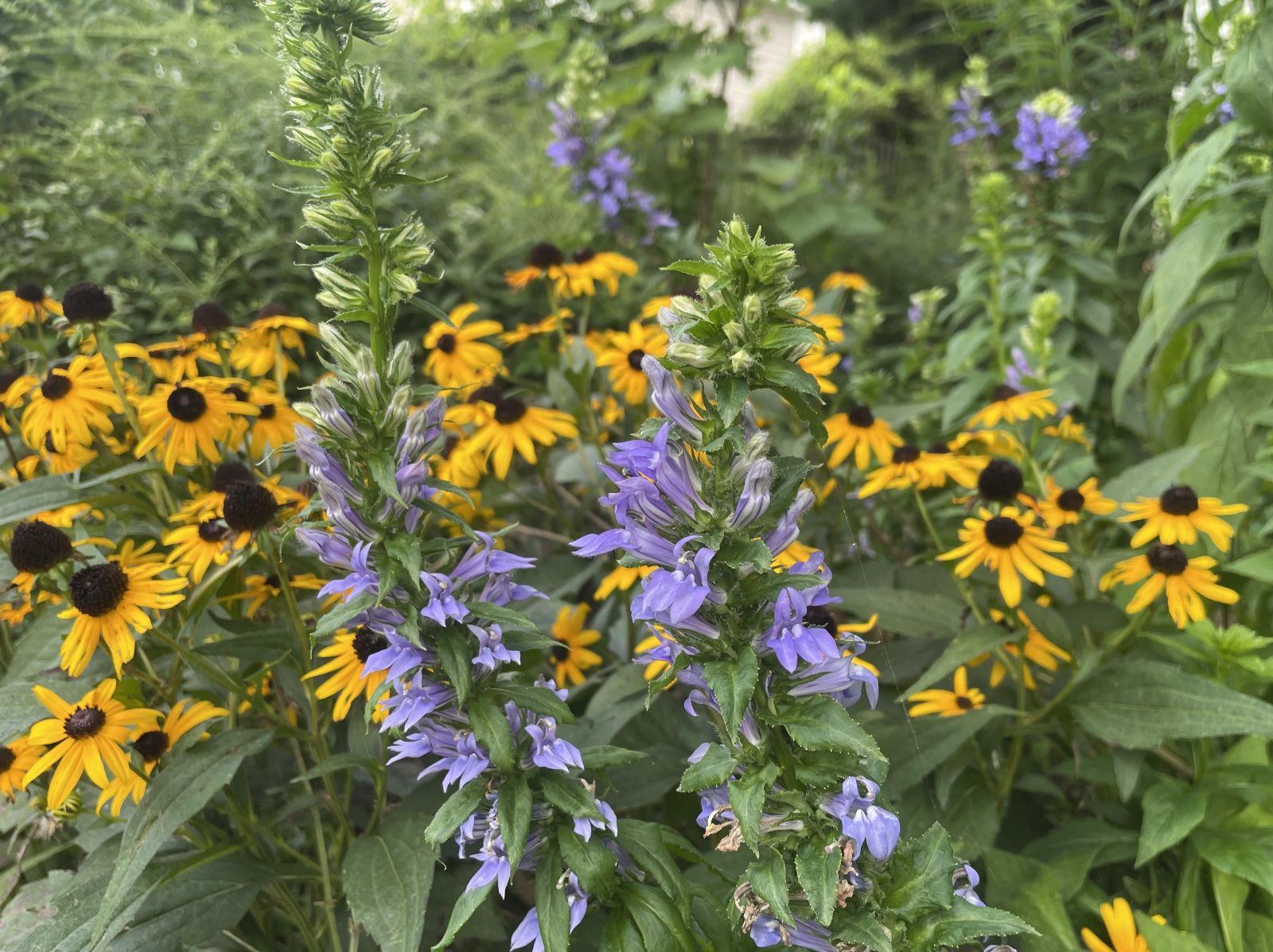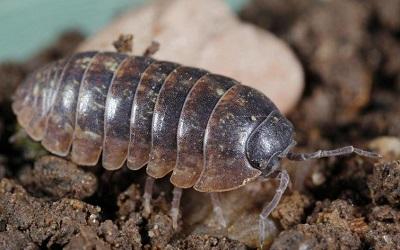
Great blue lobelia (Lobelia siphilitica) blooming in front of Rudbeckia fulgida. Photo: C. Carignan, UME
Sustainable Gardening
- Save and share seeds from flowers that have finished blooming and have dry seed heads. See our three-part seed saving video series for seed collection and storage tips. Check with your local Master Gardener program for upcoming seed shares.
- Wait on pruning perennial plants until late next spring. Certain bees and other beneficial insects use plant stems as habitat to survive the cold winter months. Only remove unhealthy plant stems to manage disease.
- Cover bare soil to discourage weeds and erosion: use cover crops in a vegetable garden, groundcover plants, and/or mulch around new landscape plants until they get established and fill in.
Trees & Shrubs
- Avoid planting one type of tree or shrub (a monoculture) when planting a living screen. Diseases and insects are typically host-specific so you run the risk of losing the entire screen if a pest or disease attacks your plants. Select several different types of trees and shrubs, both evergreen and deciduous, to prevent this from occurring.
- In most cases healthy, mature trees and shrubs do not require fertilizers. Woody plants receive nutrients from lawn fertilization if their roots are adjacent to or growing under the turf area. Their roots also take in nutrients from decaying mulches and leaves and from the minerals in the soil.
- Hold off on pruning trees and shrubs (except for dead branches, which can be pruned out at any time). Any desired pruning of summer-flowering trees and shrubs would be best done in the spring. Spring-blooming trees and shrubs can be pruned just after they finish flowering.
Edible plants
- Plant garlic late September (Western MD) through early November (Eastern Shore and Southern MD) for a late June/early July harvest next year. Plant the cloves root end down; space them 4-6 inches apart, pointy end up, and cover with 1-2 inches of soil. Mulch the garlic bed with fallen tree leaves.
- If tomato plants are rapidly declining due to disease you can pick fruits and ripen them indoors.
- Harvest pumpkins and winter squashes when the rind hardens (fruits can tolerate a light frost). Cut them from the vine leaving a 4-5 inch handle, handle gently, and store in a cool, dry location until ready to use.
- Time to plant cover crops to protect and improve the soil in your vegetable beds.
- Harvest figs when they soften slightly. Ants may enter the small eye at the bottom of the fruit as the fig ripens. Figs that are nearly ripe (fully-colored but firm) can be picked and ripened fully indoors.
- Prune out the dead raspberry and blackberry canes that fruited this past summer on canes that overwintered. Fall-fruiting raspberries and blackberries can be mowed to the ground in late winter.
Flowers
- Enjoy goldenrods and asters this month. They are important fall flowers for pollinators.
- Purchase spring-flowering bulbs like Allium, Crocus, and Anemone. Keep bulbs cool (60°- 65°F) until planting time, usually in October.
Lawns
- Do you have areas of your lawn that are growing poorly? Consider using other plants that are better adapted to those areas. Refer to The Challenge of Growing a Lawn in Maryland and Lawn Alternatives. For inspiration, these case studies and photos show how Maryland residents are adding more plant diversity in place of turfgrass.
- If you have a lawn consisting of cool-season grasses (tall fescue, fine fescue, Kentucky bluegrass), apply fertilizer in the fall and fertilize according to the UME fertilizer schedule. Make sure to sweep any fertilizer that lands on sidewalks or driveways back onto grassy areas.
- If you are renovating a lawn or repairing bare spots, use recommended cultivars of grass seed.
Insects
Beneficial
- Ambush bug adults are active and feeding on insect pests in our gardens. Support these predators by incorporating fall-blooming plants, reducing pesticide use, leaving their black barrel-shaped eggs laid on stems and leaves, and leaving non-diseased plant debris as winter habitat.
- Wheel bug and other assassin bug adults are active and feeding on a wide range of insect pests. Many species will begin laying egg masses. Support these predators by leaving these insects be (as they may poke you with their straw-like mouthpart), recognizing and leaving their egg masses be, and planting a diversity of native plants.
- Scoliid wasp adults (also known as digger wasps) are active, pollinating flowers and parasitizing scarab beetle grubs found underground. Support these important pest controllers by planting fall blooming flowers (adult wasps feed on nectar), leaving flying adults (not aggressive) and their ground nests be, and reducing pesticide use.
- Praying mantis adults are active and feeding on a wide range of insect pests. Around late September they will begin laying egg cases (ootheca). All mantid species in our area are considered beneficial predators (do not target and kill non-native mantid species). Support these predators by leaving their egg cases be, outdoors. Do not bring egg cases indoors during the fall and winter months, as the warm temperatures inside your home could cause an early emergence of immature mantids (allow them to naturally emerge in the spring).
- Bess beetle immatures (grubs) and adults are active. They feed on and break down rotting wood, helping to return nutrients back to our soils. Support these natural recyclers by leaving fallen logs where/when you can in conservation areas.
- Common buckeye butterfly adults are active and pollinating flowers (typically preferring yellow flowers). Support these late-season pollinators by planting fall-blooming plants with yellow flowers to fuel their migration south for the winter.
Pests
- Various types of caterpillars may be found feeding on the leaves of trees at this time of year. Research has shown that this late-season damage is minor to overall tree health and management of caterpillars is usually not necessary.
- You may notice European hornets stripping the bark off shrubs (especially lilac) and trees. This stripping of the bark is usually minor and does no real harm to a shrub or tree. The European hornet is a large yellow and reddish-brown wasp that nests in cavities in trees, stumps, wood piles, sheds, etc., and feeds on insects.
- Spruce spider mites are active again on evergreen trees. Monitor for this pest by tapping branches while holding a piece of white paper underneath. Look for moving specks. They can be controlled with ultra-fine horticultural oil (do not use on blue spruce). Follow label instructions.
- Spotted lanternfly adults may be found feeding on many host plants, especially tree of heaven (Ailanthus altissma). If you observe spotted lanternflies, inform the Maryland Department of Agriculture (MDA) by reporting the sighting on their website. These insects are mainly nuisance pests in residential gardens and landscapes. They have not been shown to significantly damage otherwise healthy ornamental plants. Consider sustainable management options if you want to take action.
- Fall webworm caterpillars are becoming more abundant and are creating tent-like webbing on the ends of woody plant branches. Caterpillar feeding damage is usually minimal and control is not typically needed; caterpillars are typically only active through October. Tents can be pruned out or left for natural predators (birds) and parasitoids. Do not try to burn any webbed tents. Contact a professional if you would like to prune out a tent you cannot reach safely.
- Mexican bean beetle adults are active and feed on the underside of legume leaves (lima beans, snap beans, etc.). Adult beetles will spend the winter months in plant debris. Pull up and bag infested legume plants after harvest. Watch this short tutorial on how to harvest and bag bean plants.
- Striped and spotted cucumber beetle adults are active and chewing holes in leaves, flowers, and fruit. Common host plants include cucurbits, legumes, and tomatoes. Adults spend the winter months in plant debris and soil. Remove infested debris after harvest. In the fall or spring, lightly till the soil to disrupt soil-living life stages.
- Many different cabbage-feeding caterpillars and moths are active. Check host plant leaves (mainly crucifers and brassicas) for signs of feeding damage and for the presence of caterpillars and caterpillar droppings (frass). Found caterpillars can be removed and destroyed. Remove infested plant debris after harvest to remove pest overwintering sites.
- Boxelder bug nymphs and adults are active and may congregate on boxelder trees, mulch, or in sunny areas of buildings. Adults will seek shelter for the winter, possibly finding their way indoors. This insect cannot harm humans, pets, or buildings and does not significantly damage plants. Control is generally not needed. If found indoors, vacuum or sweep up the insects.
- Many different social wasp species, like yellowjackets, will seek out sources of sugar this time of year. Keep outdoor food and beverages covered, rake up and discard fallen tree fruit, and equip trash cans with tight-fitting lids. Certain wasps may sting if they feel threatened. Avoid swatting or handling any wasps.
- Blister beetle adults are active and commonly found on goldenrod flowers or flying around lights at night. Learn to recognize and avoid these beetles, as they can release an oily substance called cantharidin when handled or squished and can cause temporary skin blisters.
Diseases
- Powdery mildew may be seen now on many trees, shrubs, and perennials, like pin oak, roses, lilac, phlox, peonies, and monarda. This fungal disease favors high humidity but unlike other fungi does not require wet weather to thrive. It usually appears on plant foliage as a grayish, powdery coating on upper leaf surfaces. When possible select resistant cultivars. No chemical control is necessary.
Miscellaneous
- Poison ivy leaves will begin to turn red this month. Don’t be fooled by their fall color change, the leaves are still very irritating. Do not handle or shred the leaves and do not burn the vines.
- Avoid storing pesticides over the winter in sheds and garages. Cold temperatures can cause these materials to become ineffective. If you have questions about the efficacy of your pesticides call the manufacturer, using the phone number listed on the label. For additional pesticide storage information visit the National Pesticide Information Center website.
Indoor plant and insect tips
Indoor plants

Photo: Joseph Berger, Bugwood.org
- Before moving houseplants back indoors check plants for ants, earwigs, pillbugs, and other nuisance insects. Wash off insect pests or apply a labeled houseplant insecticide to control any plant pests such as aphids, scales, spider mites, and mealybugs.
- Avoid wetting the leaves of fuzzy-leaved plants like African violets. Wet foliage can cause leaf spotting.
- Be careful not to overwater houseplants during the indoor adjustment period which can take several weeks.
- As houseplants that were outdoors for the summer adjust to less light indoors leaf yellowing and drop is possible.
Indoor pests
- Crickets, multicolored Asian lady beetles, boxelder bugs, stink bugs, cluster flies, and other innocuous insects may attempt to enter your home this fall to overwinter. Caulk, weatherstrip, and seal up all cracks, and entry points around your house foundation, vent openings, windows, and doorways to prevent these critters from coming indoors.
- House mice and sometimes field mice may be more noticeable around and in homes due to the onset of cool weather. Keep grass and weeds properly mowed around your house and seal all cracks.
Still have a question? Contact us at Ask Extension.